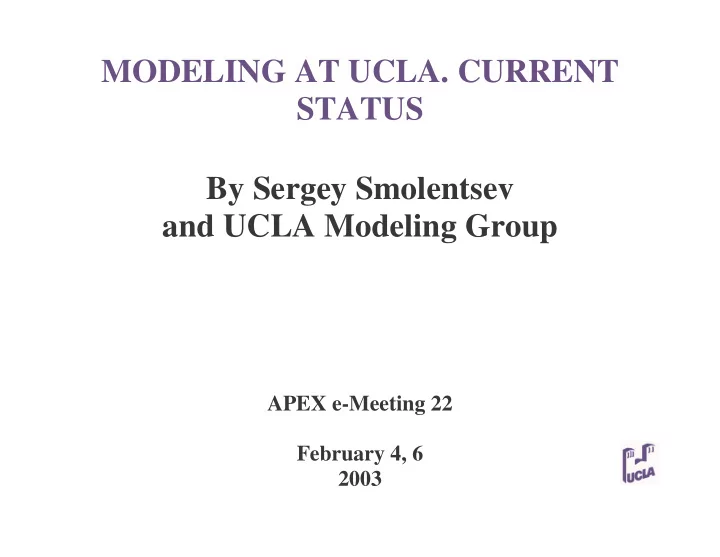

MODELING AT UCLA. CURRENT STATUS By Sergey Smolentsev and UCLA Modeling Group APEX e-Meeting 22 February 4, 6 2003
CONTENT � Benchmark case. Lid-driven cavity flow � 3-D MHD flows in non-uniform magnetic fields with j- and B-formulations � First steps towards stability analysis for jet flows in a magnetic field
Benchmark case. Lid-driven cavity flow � Classic test for 2-D, 3-D CFD Ha=45 codes Re=100 � Not extended to 3-D MHD flows yet � UCLA code 1 (Ni), Lid moves in X-direction FLUENT (Morley), B applied in Z-direction UCLA code 2 (Smolentsev), 1 HIMAG (Ni, Munipalli) 0.5 Y-coordinate 0 -0.5 -1 -1 -0.5 0 0.5 1 Z-coordinate
Benchmark case. Lid-driven cavity flow • Collocated grid � UCLA code 1 (Ni) • B-formulation • Commercial code � FLUENT (Morley) • Unstructured grid • B- or ϕ -formulation • Fully staggered grid � UCLA code 2 (Smolentsev) • B- or ϕ -formulation • Unstructured grid � HIMAG (Ni, Munipalli) • B-formulation
Benchmark case. Lid-driven cavity flow BC: B=0 at Γ 1 � UCLA code 1 (Ni) BC: B=0 at Γ 1 � FLUENT (Morley) BC 1: B=0 at Γ 2 � UCLA code 2 (Smolentsev) BC 2: B τ =0, ∂ B n / ∂ n=0 at Γ 1 BC: j n =0 at Γ 1 � HIMAG (Ni, Munipalli) Note: UCLA code 1 and FLUENT use physically incorrect BC
Benchmark case. Lid-driven cavity flow U(Y) at X=0.5, Z=0.5 1 0.9 0.8 0.7 0.6 UCLA code 1 From Mingjiu using a projection method for B 0.5 y FLUENT (B-formulation) From Neil using FLUENT to solve B UCLA code 2 (B-formulation) From Sergey by solving B formulation HIMAG From HIMAG by solving electrical potential formulation 0.4 Non-MHD flow NonMHD flow 0.3 0.2 0.1 0 -0.25 0 0.25 0.5 0.75 1 u
Benchmark case. Lid-driven cavity flow U(Z) at X=0.5, Y=0.5 0 UCLA code 1 UCLA code 2 (B-formulation) From Mingjiu using a projection method for B HIMAG From Sergey by solving B formulation -0.025 Non-MHD flow From HIMAG by solving electrical potential formulation NonMHD flow -0.05 -0.075 u -0.1 -0.125 -0.15 -0.175 -0.2 0 0.2 0.4 0.6 0.8 1 z
Benchmark case. Lid-driven cavity flow V(X) at Y=0.5, Z=0.5 0.2 0.15 0.1 0.05 0 V -0.05 v -0.1 -0.15 UCLA code 1 -0.2 FLUENT (B-formulation) From Mingjiu using projection method for B UCLA code 2 (B-formulation) From Neil using FLUENT to solve B HIMAG From Sergey by solving B formulation -0.25 Non-MHD flow From HIMAG by solving electrical potential formulation NonMHD Result -0.3 0 0.1 0.2 0.3 0.4 0.5 0.6 0.7 0.8 0.9 1 x
Benchmark case. Lid-driven cavity flow � All codes demonstrated excellent agreement in non-MHD case. � The velocity field is almost insensitive to the BCs on B even though they are not quite correct. � Fluent with ϕ -formulation had no convergence. � UCLA code 2 with ϕ -formulation converged but the result was very different from other calculations. � HIMAG with ϕ -formulation converged and the result agreed well with other calculations. � In MHD case all calculations demonstrated reasonable agreement. Higher discrepancy in U(Z) can be explained by a strong impact of the Hartmann layers on the flow, which were probably resolved differently by different codes.
3-D MHD flows in non-uniform magnetic fields with j- and B-formulations GOALS S � Implementation of different MHD formulations � Comparisons with other codes Y X � Application to APEX Z � Construction of divB=0, rotB=0 applied magnetic fields N
3-D MHD flows in non-uniform magnetic fields with j- and B-formulations � Analytical solution for a 3-D magnetic field in the gap between the magnetized plates was used to describe the applied magnetic field � B-formulation � J-formulation is being tested Computations by Sergio Cuevas. More results will be presented at the next APEX Meeting.
First steps towards stability analysis for jet flows in a magnetic field Rayley-Weber classic theory of capillary jet disintegration 1 1 = ω = k = + L / d C ( 1 3 La ) We + + 2 2 ( 1 3 La ) 2 ( 1 3 ) La 0 Similar approach is used to study capillary jet break up in a magnetic field (radial). Preliminary analysis showed significant increase in L/d 0 as the magnetic field grows. B-field L
Recommend
More recommend